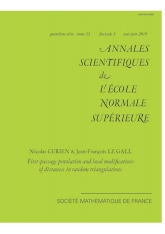Percolation de premier passage et perturbations locales des distances dans les triangulations aléatoires
First-passage percolation and local modifications of distances in random triangulations

- Consulter un extrait
- Année : 2019
- Fascicule : 3
- Tome : 52
- Format : Électronique
- Class. Math. : 05C80; 60K35
- Pages : 631-701
- DOI : 10.24033/asens.2394
Nous étudions l'effet de perturbations locales de la distance de graphe dans les grandes triangulations planaires aléatoires. Nous montrons qu'à grande échelle, la nouvelle distance se comporte comme $c$ fois la distance de graphe où $c$ est une constante déterministe dépendant du type de la perturbation effectuée. Cela s'applique en particulier à la métrique de percolation de premier passage obtenue en donnant des longueurs i.i.d. à chaque arête, à la distance de graphe sur la carte duale et au modèle d'Eden (percolation de premier passage avec poids exponentiels sur la carte duale). Dans les deux derniers cas, nous pouvons même calculer explicitement la constante $c$ en utilisant un lien avec le processus d'épluchage (peeling process). En général, la constante $c$ reste inconnue et provient d'un argument de sous-additivité appliqué à un modèle infini de triangulation du demi-plan qui décrit la structure d'une grande triangulation aléatoire près du bord d'une grande boule centrée à l'origine. Nos résultats s'appliquent également à l'UIPT et montrent que les grandes boules pour la distance modifiée sont proches de boules pour la distance de graphe initiale.

